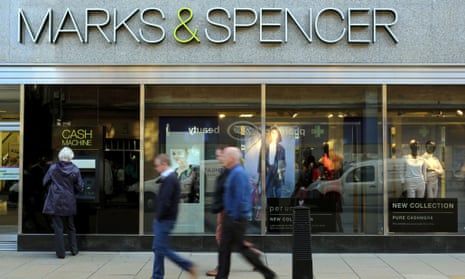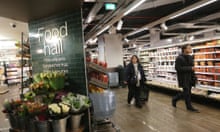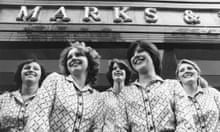Shares in Marks & Spencer soared on Wednesday as long-suffering investors glimpsed chinks of light at the end of the tunnel after the high street retailer reported its first increase in profits in four years and lifted its dividend.
The stock jumped nearly 10% after the City shrugged off the retailer’s 13th quarter of declining clothing sales, reassured by chief executive Marc Bolland’s promise that it was making a bigger profit on the fashion it did actually sell after striking better deals with suppliers and cutting back on store discounts.
After four years in charge Bolland refused to hail a recovery but pointed to “encouraging” signs, especially in its key womenswear department. “We could certainly see positive signs if we look at the womenswear trend,” he said. “Consumers are coming back to us and saying: ‘M&S has got the style back.’”
But he admitted the balmy autumn had brought to an end a nascent resurgence in womenswear. Like-for-like sales growth of 0.7% for the first five months of the period wilted in September as shoppers shunned new ranges of winter coats, jackets and boots. The collapse in trade during September – which forced rival Next to issue a profit warning last week – meant underlying womenswear sales at M&S ended up falling almost 1% over the six months to 27 September. Overall UK like-for-like sales of general merchandise, which includes clothing and homewares, fell 4% in the second quarter.
Bolland said the weather meant the retailer was now sitting on a bit more stock than expected but insisted there was “no massive overhang”. He also voiced confidence that sales would pick up as temperatures start falling: “We are able to trade it well if we see the weather turning.”
The sales picture was not helped by a slump of more than 6% at M&S.com as customers struggled to get the hang of its new £150m magazine-style website. Close to five million customers have registered on the company-owned site but that is shy of the six million that logged on to the previous one run by Amazon. Bolland said sales had now stabilised at the site and he expected them to be growing again before Christmas.
Despite the various challenges, the group surprised the City by reporting a rise in underlying first-half profits, up 2.3% to £268m, thanks to higher margins and lower costs. It is also increasing its dividend payment to shareholders for the first time since 2010, with an interim payment of 6.4p, up from 6.2p. The shares closed up 39.4p at 444.1p.
M&S said it had managed to boost clothing profit margins by buying fabric from fewer places and getting existing suppliers to move production to lower-cost countries. Bolland gave the example of buying linen from eight – rather than 28 – mills, and promised bigger gains in the second half. The drive to improve clothing profit margins would not compromise M&S’s ethical sourcing policies, he insisted.
The most recent clothing collections have been well received by the fashion press with the retailer now changing over the ranges in its stores more frequently and promising that clothes featured in its adverts can actually be found in branches all over the country. Bolland brought in a new design team two years ago fronted by former Debenhams chief executive Belinda Earl as style director in response to criticism that the clothes were too frumpy. Last winter a much-hyped pink coat modelled by Karen Elson sold out within days, leaving the company under fire for advertising items only available in a few flagship stores.
M&S’s food business continued to be a bright spot, notching up its 20th consecutive quarter of growth. Like-for-like sales rose 1% aided by a stream of new product launches including ready meals and frozen foods. That figure was a slight slowdown but it is still judged to be a good outcome in a sluggish grocery market and the retailer has upped its expansion plans to 200 standalone Simply Food stores.
“We feel that M&S may have finally turned a corner,” said Jefferies analyst Caroline Gulliver, pointing to M&S’s apparent confidence in both its UK clothing and food ranges as well as the website’s improvements. “Overall it seems M&S could finally be moving in the right direction.”
Bolland, poached from grocer Morrisons with great fanfare in 2010, has spent more than £2.3bn addressing decades of underinvestment, overseeing the revamp of its products, stores, website, logistics and marketing. But some analysts argue more still needs to be done. “Beyond the flagship stores, many still feel like museums where older people go to browse black slacks,” said Phil Dorrell, director of the retail consultancy Retail Remedy.
While market conditions remain “challenging” Bolland appeared upbeat before the key Christmas trading period. “Customers are telling us there’s some money to be spent over Christmas and that they are interested in something new. They don’t want to reuse the same Christmas decorations or hold back on gifting, because they can afford to spend a bit more.”
M&S food: a global brand?
With its gastropub-style ready meals, shortbread fingers and bottles of prosecco, M&S’s food business is the national flag carrier for Britain’s favourite treats and tipples. In recent years the retailer has become more ambitious with its foreign postings, with new stores in Hong Kong the most exotic on a list that has also included openings in Paris and Prague over the last six months.
M&S has operated a small chain of predominantly clothing shops in Hong Kong since 1988 but upped the ante with its two standalone food store openings. Food parcels of cheddar cheese and ready meals are flown in regularly on Virgin airliners while shorter shelf-life foods such as sandwiches and salads are sourced locally. Surprise bestsellers there include redcurrant puffs, custard creams, shortbread fingers and wine gums, according to the retailer.
City analyst Louise Cooper sees huge potential for the M&S food brand overseas: “M&S has positioned itself as the Heston Blumenthal of food retailing. It could be a global brand like Starbucks.”








Comments (…)
Sign in or create your Guardian account to join the discussion